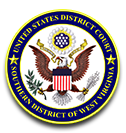District Court Fees
- Fee Schedule (December 1, 2023)
- Transcript Fees
- Witness fees are $40.00 per day plus round-trip mileage from your home to the courthouse at the rate set by the United States General Services Administration.
Post Judgment Interest Rates
- Post Judgment Interest Rates
- Interest on Judgments, Chapter 16, District Clerk's Manual
- Director's Memorandum Re: Interest Rates on Judgments in the Federal Courts
- Instructions for Post Judgment Interest Rate Data Download Program
Interest is allowed on most judgments entered in the federal courts from the date of judgment until paid. The types of judgments generally fall under one of three statutes:
- 28 U.S.C. 1961, which governs civil and bankruptcy adversary judgment interest;
- 18 U.S.C. 3612 (f)(2), which governs criminal judgments or sentences; and
- 40 U.S.C. 3116, which governs deficiency judgments in condemnation proceedings.
These statutory references should be checked with reliable statutory data bases such as Westlaw. Lexis, or other appropriately maintained sources of the U.S. Code for the latest changes.
Under each of the above statutes the rate of interest used in calculating the amount of post judgment interest is the weekly average 1-year constant maturity (nominal) Treasury yield, as published by the Federal Reserve System. Prior to December 21, 2000 the rate of interest allowed under the statutes cited above was based on the coupon issue yield equivalent (as determined by the Secretary of the Treasury) of the average accepted auction price for the last auction of 52 week t- bills settled immediately preceding entry of the judgment. (See Director’s Memo, February 28, 2001).
The way the rate is used differs under each of the cited statutes, so those sections should be reviewed to determine how to apply it to any particular judgment.
Current Applicable Rates
The current rate applicable under these sections is provided by the Federal Reserve and published each Monday for the preceding week (unless that day is a holiday in which case the rate is published on the next business day).
The specific rate referred to in the statutes is found in the table under the two columns headed WEEK ENDING. The two dates under those columns refer to the Friday averages of the last two weeks. Under those columns you need to go down to the row which states U.S. government securities - Treasury constant maturities nominal 10 - 1-year. Where the row and columns meet - that is the rate you use.
Prior current rates also are available by selecting the week preceding the date of judgment (or the date interest would otherwise apply under the above) and selecting the release date preceding the date of judgment. NOTE: if your judgment date is the same as the release date, you should select the prior week’s release. REASON: the releases are considered to be issued at the close of business on the date of release.
Rates Prior to December 21, 2000
Rates under the prior language were based on the average accepted auction price for the latest auction of 52 week t-bills.
Chapter 16: Judgment and Post Judgment Remedies
Pursuant to 28 U.S.C. 1961, post judgment interest shall be allowed on any money judgment in a civil case recovered in a district court. The interest is calculated at a rate equal to the weekly average 1-year constant maturity Treasury yield, as published by the Board of Governors of the Federal Reserve System, for the calendar week preceding the date of the judgment. In some cases, pre-judgment interest may be award by the court in accordance with a statue or a contract provision and the amount will be stated in the judgment. Interest is computed daily and compounded annually. In some cases, pre-judgment interest may be awarded by the court in accordance with state law or a contract provision and the amount will be stated in the judgment.
The current post judgment interest rate can be found at: https://www.uscourts.gov/court-programs/fees/post-judgment-interest-rate and http://federalreserve.gov/releases/h15/.
